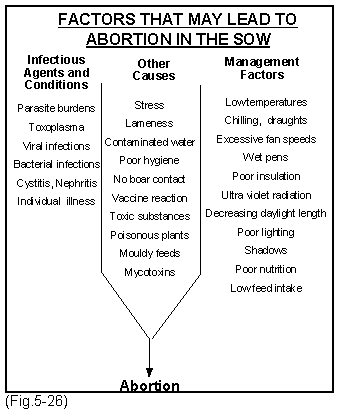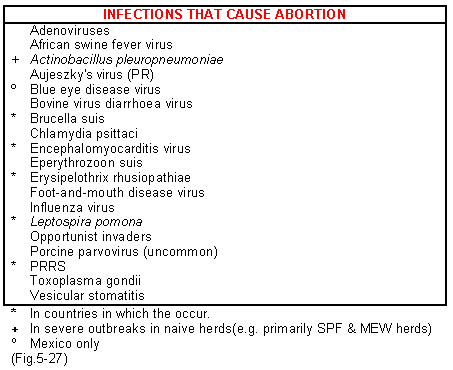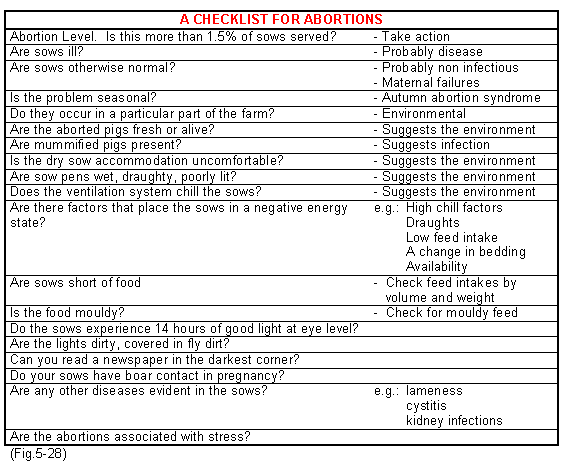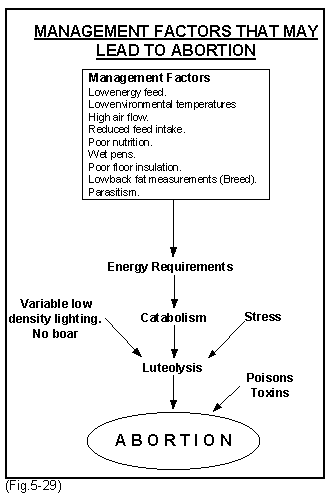



Infectious causes of loss
Fig.5-26 shows those factors that contribute to abortions of either infections or management factors that cause regression of the corpus luteum (luteolysis). Infectious agents can act in several ways. They may invade and kill the foetuses, and/or they may multiply in the placenta cutting off the blood supply to the foetuses, or they may cause a generalised infection of the sow making her feverish and ill resulting in abortion.

Abortions can also be associated with mouldy feeds. To prevent this:
- Always check your feed bins. Are they water tight?
- When were they last inspected internally?
- Do they contain bridged mouldy feed?
- Are the bins filled with warm feed?
- Do you regularly treat the bins to prevent mould growth.
- Are the bags of feed kept in a dry cool or wet warm place?
- If you practice home mixing and wet feeding are the tanks and pipes mould free?
- Are you ever tempted to give feed to sows that has been slightly mouldy.
If you wet feed:
- Do you check the roofs of your mixing tanks to see whether feed splashed on to them has gone mouldy.
- Do you check the pipes?
- Do you check the source materials?
- Do you let liquid components of the mix sit around in hot weather in storage tanks?
Abortion can also result from mycotoxins in a feed component (e.g. grain). These toxins are produced by fungi growing when the feed component was itself being grown or stored. Some of them cross the sows placenta and cause abortions. Others affect the sow and result in abortion.
Infectious causes of abortion are listed in Fig.5-27 and are included here purely has a guide or checklist. See chapter 6. Other bacteria not listed here can be associated with sporadic abortion in individual sows for e.g. E. coli, klebsiella, streptococci and pseudomonas although if several sows are affected it can start to look like a herd problem.

Some of these other bacteria are normal inhabitants of the vagina and their identification following pathological examinations needs careful interpretation. An emerging syndrome in this category occurs when high numbers of organisms are deposited into the anterior vagina, particularly towards the end of the heat period, by the boar. A variety of opportunist bacteria may be involved including klebsiella, streptococci, staphylococci and leptospira. In such cases careful clinical examination of sows between 14 and 21 days post mating sometimes reveals a tacky discharge on the vulva which may not necessarily be very obvious. Such sows should be identified, and if they are returning out of cycle, it is likely that very early embryonic loss is occurring. See chapter 6 Endometritis.
Low grade or chronic infections such as cystitis (infection of the bladder) and nephritis (infection of the kidneys) occasionally result in abortion. Lameness and pain, particularly coming from abscesses in the feet or leg weakness (osteochondrosis) can also cause the corpus luteum to regress due to stress. Bullying and fighting are often forgotten as predisposing factors in individual sows. Clinical examinations and study of records are important tools for investigation. The stockpersons opinions and observations are often invaluable.
A checklist is shown in Fig.5-28. If you can satisfy all these criteria you will not have an environmentally induced problem. Fig.5-29 collects together all the precipitating factors associated with the epidemiology of environmentally induced disease.








